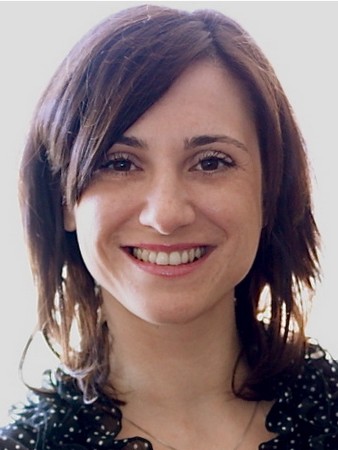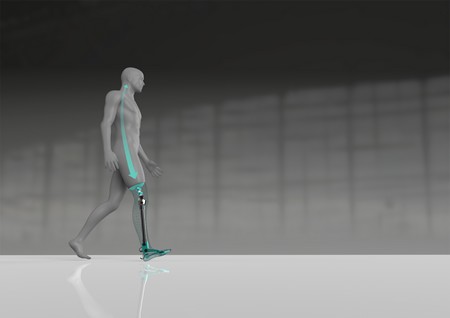European research project to build new generation of leg prostheses
A team of seven research institutes has received a large European grant to build a new generation of leg prostheses. The design should allow amputees to walk more naturally, as the new leg will adapt to different walking patterns and be controlled by electrical impulses from the brain. University of Groningen robotics engineer Raffaella Carloni will lead the EUR 4.5 million project, which has its official kick-off on 16 and 17 April.
The project is titled MyLeg – Smart and intuitive osseointegrated transfemoral prosthesis embodying advanced dynamic behaviors , and its aim is to design a novel prosthetic system for amputees who have lost a leg from above the knee. ‘We want to develop a transfemoral prosthesis that can be intuitively operated, sensed and trusted as a healthy and reliable counterpart for a variety of tasks’, explains Carloni, an associate professor in the Artificial Intelligence and Cognitive Engineering research institute of the University of Groningen.

Brain
The new prosthesis, says Carloni, will combine three major features. ‘First, it will be fixed to the femoral bone via an osseointegrated implant.’ Most current prostheses are connected to the stump via a socket, but the interface of stump and socket can cause discomfort. Second, the leg will be powered by a novel actuation system, which will include motors and springs. This will make it possible to adapt the prosthesis to different walking patterns and terrains.
‘It should have a degree of mechanical compliance, just like a healthy leg. Depending on the walking pattern or terrain, our muscles can make our legs more compliant or stiffer’, explains Carloni. The third feature will be the intuitive control of the prosthesis by electrical impulses from the brain. Carloni: ‘We will implant myoelectric sensors in the stump muscles to interpret the amputee’s intention and will use this to control the prosthesis.’
Mechatronics
The big step that the MyLeg project will take is to integrate these three main features, thanks to a multi-disciplinary team. The team includes roboticists, biomechanical and biomedical engineers, surgeons who are experts in osseointegration and implanting electromyographic sensors, physiotherapists and gait experts.

As a robotics scientist, Carloni will work on the mechatronic design of the prosthesis, the actuation system and its intuitive control. She will supervise PhD students and postdoctoral researchers in the Robotics research lab in the Bernoulliborg on the Zernike Campus.
As project coordinator, Carloni will host the kick-off meeting of the MyLeg project in Groningen on 16 and 17 April 2018. ‘The kick-off meeting will include presentations by the the MyLeg project partners and discussions with several amputees’, says Carloni a week before the event. Amputees will be needed for testing during the project. ‘We will first test different components of the prosthesis and by the end of the project, in four years’ time, we will test a fully functioning prototype.’
The €4.5 million MyLeg project is funded by the European Union’s Horizon 2020 framework programme (€4 million) and the project partners (€0.5 million). More information can be found on http://www.myleg.eu/

Partners in MyLeg:
University of Groningen (the Netherlands): the team is based with the Robotics Group of the Faculty of Science and Engineering. Its main focus is the development of novel actuation systems, which are the key enabling components for motion generation. The work will be accomplished by developing unique mechanical designs and intelligent control architectures.
University of Bologna (Italy): the team at the University of Bologna is based at the Interdepartmental Centre for Industrial Research at the University of Bologna, which works in the field of advanced applications in mechanical engineering and materials technology.
Roessingh Research and Development (the Netherlands): Roessingh Research and Development is a research and development SME that specializes in rehabilitation technology and telemedicine and has strong formalized links to one of the largest rehabilitation centres in the Netherlands (Roessingh Rehabilitation Center).
Radboud University Medical Center: the team at Radboud University Medical Center is affiliated with the Orthopaedic Research Laboratory, which has expertise in the development, monitoring and statistical analysis of clinical studies. Furthermore, it is one of the world’s leading laboratories in osseointegration and failure analyses of orthopaedic hip and knee implants.
ÖSSUR (Iceland): this company was founded by Össur Kristinsson, a prosthetist and an amputee. The company originally started life as a prosthetic clinic in 1971, steadily building a world-class reputation for the design and production of prosthetic liners, sockets and locking systems. More than 130 people at Össur are currently working on R&D in Iceland, France and the USA.
University of Twente: the team is affiliated with the Biomechanical Engineering group. Their research focuses on the interaction between the human motor system and medical devices that support this system. The result of this research is applied in the development of innovative devices.
Norwest Advanced Orthopaedics (Australia): this private orthopaedic clinic is based in Sydney. Professor Munjed Al Muderis and specialists from the Osseointegration Group of Australia provide above and below knee amputees with a leg replacement that uses an OPL implant, which is designed to be as close to the human anatomy as possible.
| Last modified: | 05 June 2018 3.50 p.m. |
More news
-
10 June 2024
Swarming around a skyscraper
Every two weeks, UG Makers puts the spotlight on a researcher who has created something tangible, ranging from homemade measuring equipment for academic research to small or larger products that can change our daily lives. That is how UG...
-
21 May 2024
Results of 2024 University elections
The votes have been counted and the results of the University elections are in!
